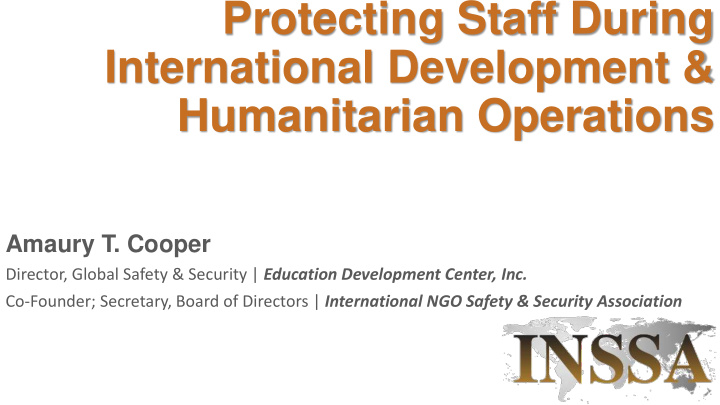



Protecting Staff During International Development & Humanitarian Operations Amaury T. Cooper Director, Global Safety & Security | Education Development Center, Inc. Co-Founder; Secretary, Board of Directors | International NGO Safety & Security Association
Aid Worker Security Incidents, 2004 - 2014 Courtesy of Aid Worker Security Database | www.aidworkersecurity.org
Major Attacks on Aid Workers, 2004 - 2014 Courtesy of Aid Worker Security Database | www.aidworkersecurity.org
Most Violent Settings, 2014 Courtesy of Aid Worker Security Database | www.aidworkersecurity.org
History of ID/HA Security Relatively new field Existed, but not codified Less than 10 years Little/no organizations had actual plans and policies Divided into three eras of ID/HA Cold War years, Post-Cold War – September 10, 2001 Post-9/11
ID/HA Security, Yesterday, Today, Tomorrow What ID/HA Security was Cold War Era Had de facto protection from Cold War powers. We’re helping the people so they won’t hurt us. Little/no donor support/funding for safety and security. No staff training
ID/HA Security, Yesterday, Today, Tomorrow What ID/HA Security was Post-Cold War – 9/10/2001 No more protection from Cold War powers. Relied entirely on good will of community. o Acceptance Model Safety/security seen as additional cost, not relevant to program/project goals. Little/no donor support/funding for training. Staff training, if any, focused heavily on expatriate staff
ID/HA Security, Yesterday, Today, Tomorrow What ID/HA Security is now Post-9/11 Growing recognition that ID/HA can no longer depend on goodwill and reputation for protection Better understanding Duty of Care More willing to allocate resources to safety & security. Growing acceptance that safety/security as important to program implementation as delivering services Donors proactively requiring threat/security assessments from ID/HA Recognition of how safety/security plans, protocols procedures can not only protect staff, but also reduce costs, safeguard company assets/reputation, extend programming, ultimately better serve beneficiaries
Who are the staff? Aid Workers Beta and 1.0 Aid Workers 2.0 The Cowboys The Tree Huggers
Challenges Operating Environment Organizational Level Donor Level National Government Level International Level Individual Level
ID/HA Security Manager Description Perception All gun totting former military, intel; Will always say “NO”; Make things more complicated and more expensive; Because they hired you, nothing bad will ever happen; Have a direct line to Seal Team VI to rescue them
ID/HA Security Manager Description Reality Enable the delivery of international development and humanitarian assistance Never/rarely say no Get them out when things go south Given the opportunity, will reduce costs and help them plan for those “Oh shit” moments Of course take the blame for everything that goes wrong
Changing ID/HA Landscape Technology Logistics Communication Duty of Care
ID/HA Security, Yesterday, Today, Tomorrow What NGO Security could be? Should be?!...Will be!! Full integration of safety/security into program design and implementation. All staff are trained and compliant Understand that safety/security goes beyond “guards, gates, guns” Acknowledgement that ROI is a factor Established international legal frameworks for the implementation of safety/security
Amaury T. Cooper Director, Global Safety & Security Education Development Center, Inc. (EDC, Inc.) acooper@edc.org | @amaurycooper | www.edc.org Co-Founder; Secretary, Board of Directors International NGO Safety & Security Association (INSSA) inssaonline@inssa.ngo | www.inssa.ngo | @INSSAOnline
Recommend
More recommend